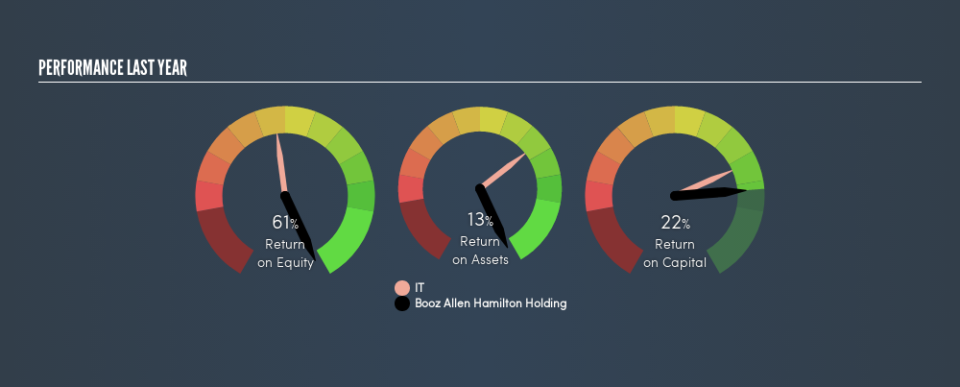Are Booz Allen Hamilton Holding Corporation’s (NYSE:BAH) High Returns Really That Great?

Want to participate in a short research study? Help shape the future of investing tools and receive a $20 prize!
Today we are going to look at Booz Allen Hamilton Holding Corporation (NYSE:BAH) to see whether it might be an attractive investment prospect. Specifically, we’re going to calculate its Return On Capital Employed (ROCE), in the hopes of getting some insight into the business.
First of all, we’ll work out how to calculate ROCE. Then we’ll compare its ROCE to similar companies. Finally, we’ll look at how its current liabilities affect its ROCE.
Understanding Return On Capital Employed (ROCE)
ROCE measures the ‘return’ (pre-tax profit) a company generates from capital employed in its business. Generally speaking a higher ROCE is better. Overall, it is a valuable metric that has its flaws. Renowned investment researcher Michael Mauboussin has suggested that a high ROCE can indicate that ‘one dollar invested in the company generates value of more than one dollar’.
So, How Do We Calculate ROCE?
The formula for calculating the return on capital employed is:
Return on Capital Employed = Earnings Before Interest and Tax (EBIT) ÷ (Total Assets – Current Liabilities)
Or for Booz Allen Hamilton Holding:
0.22 = US$520m ÷ (US$3.8b – US$1.1b) (Based on the trailing twelve months to December 2018.)
Therefore, Booz Allen Hamilton Holding has an ROCE of 22%.
See our latest analysis for Booz Allen Hamilton Holding
Is Booz Allen Hamilton Holding’s ROCE Good?
When making comparisons between similar businesses, investors may find ROCE useful. In our analysis, Booz Allen Hamilton Holding’s ROCE is meaningfully higher than the 10% average in the IT industry. I think that’s good to see, since it implies the company is better than other companies at making the most of its capital. Setting aside the comparison to its industry for a moment, Booz Allen Hamilton Holding’s ROCE in absolute terms currently looks quite high.
Remember that this metric is backwards looking – it shows what has happened in the past, and does not accurately predict the future. ROCE can be misleading for companies in cyclical industries, with returns looking impressive during the boom times, but very weak during the busts. This is because ROCE only looks at one year, instead of considering returns across a whole cycle. Since the future is so important for investors, you should check out our free report on analyst forecasts for Booz Allen Hamilton Holding.
How Booz Allen Hamilton Holding’s Current Liabilities Impact Its ROCE
Current liabilities include invoices, such as supplier payments, short-term debt, or a tax bill, that need to be paid within 12 months. Due to the way the ROCE equation works, having large bills due in the near term can make it look as though a company has less capital employed, and thus a higher ROCE than usual. To counteract this, we check if a company has high current liabilities, relative to its total assets.
Booz Allen Hamilton Holding has total liabilities of US$1.1b and total assets of US$3.8b. As a result, its current liabilities are equal to approximately 29% of its total assets. A minimal amount of current liabilities limits the impact on ROCE.
What We Can Learn From Booz Allen Hamilton Holding’s ROCE
This is good to see, and with such a high ROCE, Booz Allen Hamilton Holding may be worth a closer look. Of course you might be able to find a better stock than Booz Allen Hamilton Holding. So you may wish to see this free collection of other companies that have grown earnings strongly.
If you are like me, then you will not want to miss this free list of growing companies that insiders are buying.
We aim to bring you long-term focused research analysis driven by fundamental data. Note that our analysis may not factor in the latest price-sensitive company announcements or qualitative material.
If you spot an error that warrants correction, please contact the editor at editorial-team@simplywallst.com. This article by Simply Wall St is general in nature. It does not constitute a recommendation to buy or sell any stock, and does not take account of your objectives, or your financial situation. Simply Wall St has no position in the stocks mentioned. Thank you for reading.

